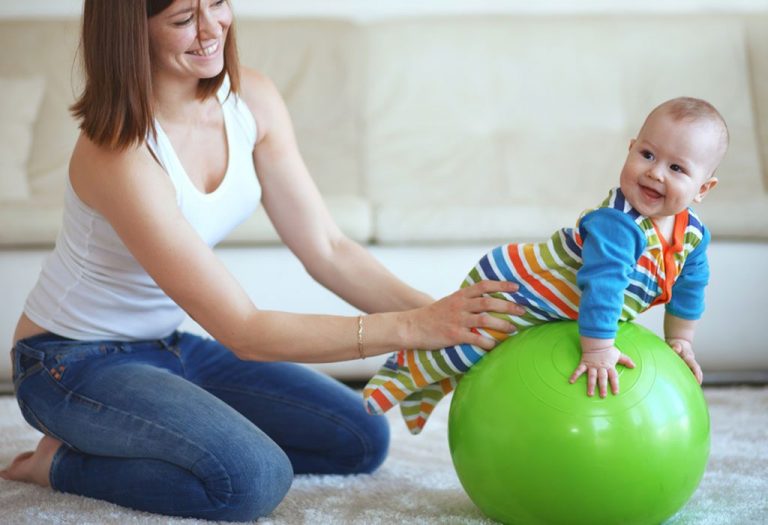14 Easy Exercises for Infants

Infants need at least one hour of exercise each day. Regular movement not only supports their physical development but also promotes healthy brain growth and coordination. By encouraging your child to exercise early on, you will be setting the foundation for a fit lifestyle later as your baby grows up. There are various exercises for babies that parents can try, such as gentle stretching or tummy time, which strengthen their muscles and improve mobility. Additionally, parents can engage in exercises with newborn babies, like simple leg movements or holding their hands to assist with stretching. Introducing some exercise for infants at an early stage helps build healthy habits and fosters bonding between parents and their little ones.
Why Do Infants Need to Exercise?
Newborn exercise is essential because it helps infants in their motor development. Strengthening the muscles will help the baby to roll over, hold his head up, crawl, and walk. Also, exercise can help baby sleep better and be less fussy.
Useful Baby Exercises for Different Ages
Looking for exercises to do with a newborn? Here are some baby development exercises that you can get your infant to do at different ages to help strengthen the muscles.
1. Exercises for 0-6-Month-Old Babies
Babies keep moving their hands and legs and are seldom quiet at this age. Doing exercises with regularity will lead a baby to look forward to spending time with you.
a. Grip the Finger
This is an exercise to help strengthen muscles in the baby’s arms, shoulders, core, and back. This exercise can be started sometime after six weeks of age.
How to Do This Exercise
Lay baby on his back and offer your index fingers for him to grasp. As soon your baby gets a firm grip, gently pull back your hands. Do this till the baby is almost in a sitting position or near to your face. Then, slowly ease him back down.
b. Tummy Time
Babies tend to spend the majority of their time lying on their backs. It is important to put your baby on his stomach for a few minutes at a time to encourage the development of muscles in the stomach, shoulders, back, and neck. It is one of the exercises to help your baby crawl well.
How to Do This Exercise
Put baby down on his tummy on a play mat or a firm mattress. Initially baby may not do much, but slowly your child will push himself up with the forearms to look around.
c. Cycle Away
A good way of providing baby relief from gas troubles, it also helps strengthen the abs, legs, hips, and knees. This infant exercise is good for baby’s range of motion and to enhance flexibility.
How to Do This Exercise
Place baby on his back on a firm surface. Then hold baby’s legs with your hands and slowly move one leg towards the chest while stretching the other as if pedalling a bicycle.
d. Lifting Weights
This is a great exercise to help improve baby’s hand-eye coordination besides strengthening the shoulder, arm, and hand muscles. Start this exercise once the baby is adept at grasping items.
How to Do This Exercise
Put baby in a bouncy chair or high chair. Place an assortment of objects and encourage him to pick them one by one. Get baby to choose an item, examine it, and then place it back before moving to the next one.
e. Reaching for Toys
This activity helps develop a baby’s motor skills and hand-eye coordination. It also strengthens the arms and shoulders.
How to Do This Exercise
Place baby on his back or tummy and dangle a soft toy or rattle just within reach. Encourage your baby to stretch out and grab it. Move the toy slightly to encourage further movement.
f. Gentle Side Rolls
This exercise promotes flexibility in the baby’s body and aids in the early development of rolling skills.
How to Do This Exercise
Lay baby on his back on a soft surface. Hold baby’s hands gently and guide him to roll slightly to one side, then back to the center. Repeat on the other side. Make sure the movements are slow and comfortable for the baby.
2. Exercises for 6-12-Month-Old Babies
Most babies at this age are attempting to sit up on their own. Some babies might be trying to crawl or be mobile in some way. By 11 months, a good number of babies can also stand up with support.
a. Try the Toe to Ear Move
Targeted at baby’s leg and calf muscles, this is among exercises to help baby walk comfortably later on.
How to Do This Exercise
Get baby to lie on his back. Then keep his leg straight as you slowly move the right toe to the left ear and back. Repeat this with the other foot.
b. Do the Wheelbarrow
Baby is sure to have fun with this exercise. One of the effective baby head control exercises, the wheelbarrow targets the whole body.
How to Do This Exercise
Get baby to lie on his stomach. Then put your hand on his tummy and lift up the lower half of his body slowly. The upper body weight has to be supported by the baby’s arms and hands.
c. Tug Up Baby
Ideal for enhancing strengthening baby’s back and core muscles, this is akin to the sit-ups that adults do. Here, you do the hard work while your baby has all the fun.
How to Do This Exercise
Grasp both of your baby’s forearms and pull him up to a sitting posture. Ensure that his back is upright. Then slowly lay him back down flat on the surface.
d. Climb a Mountain
This game helps blend playtime with exercise time. It is ideal for building up the leg muscles.
How to Do This Exercise
You can sit on the floor or a firm surface with legs extended and bent at the knees. Place baby on your lap and hold him firmly. Then lean back a little and get baby to walk over your body.
3. Exercises for 1-2-Year-Old Babies
Exercises at this age are targeted at helping baby achieve control over his body.
a. Try the Lay-Back
This is aimed at the muscles on the baby’s back as well as the abdomen and arm.
How to Do This Exercise
Lay on the floor with the baby lying flat on his back between your legs which are bent at the knee. Grasp baby’s arms and wrists as you pull him up to a sitting position before lowering him back.
b. Touch and Feel
Aimed at strengthening baby’s upper back, legs, arms, and shoulders, this exercise also boosts flexibility.
How to Do This Exercise
Place baby on your lap facing front and leaning against you. Grasp his right ankle and left hand as you slowly bring them together. Then slowly stretch out the arm and the leg.
c. Try Squatting
Ideal for strengthening those legs, quadriceps muscles, and knees to help baby walk and run better.
How to Do This Exercise
Stand next to each other and ask the baby to mimic your moves. Bend your knees and come down to the floor and squat. Place your hands on the floor for support and then come back up.
d. Hip Lift
Besides helping baby with flexibility, this exercise makes his back muscles stronger.
How to Do This Exercise
Place your baby on the back with his knees bent and feet on the floor. Put your hand under his waist while you support his back. Get your baby to lift his trunk up and hold the position for a few seconds. Then ease him back.
Some Important Exercise Guidelines for Infants
Introducing physical activity to your infant is essential for their healthy growth and development. Here are some important guidelines to follow when engaging in exercises with infants to ensure they remain safe and enjoy the process:
- Introduce exercises gradually and avoid overexerting your infant. Keep sessions short, especially during the initial stages.
- Ensure the surface you use for activities, such as play mats or firm mattresses, is clean and safe for the baby to lie on.
- Never leave your infant unattended during exercises. Your presence ensures safety and gives them confidence to explore movement.
- Pay attention to your baby’s mood and comfort level. Stop if they seem tired, fussy, or uninterested.
- Begin tummy time as early as possible to strengthen neck, back, and shoulder muscles. Start with 1-2 minutes and gradually increase the duration.
- Use toys, rattles, or colorful objects to make exercises engaging and fun for your baby.
- Let your baby explore movements naturally. Avoid forcing them into positions they are not ready for developmentally.
- Tailor activities to suit your infant’s developmental stage, focusing on gentle stretches, tummy time, and other simple exercises.
- Make exercise a part of your daily routine to help your baby adapt and develop a habit of staying active.
- Wash your hands and the baby’s hands before and after exercises to keep germs at bay, especially if toys or mats are used.
FAQs
1. Can baby exercises help with correcting posture early on?
Yes, specific movements and activities designed to engage a baby’s neck, back, and shoulder muscles can encourage proper posture development. These exercises promote strength and balance, reducing the likelihood of postural issues as the baby grows.
2. Do baby exercises help improve breathing patterns?
Yes, certain movements that gently stretch and activate the torso and diaphragm can support better respiratory development. These exercises can help improve a baby’s lung capacity and breathing efficiency over time.
Always exercise with the baby when he is in a good mood. And remember not to force your baby to do any exercise that he does not like doing or finds difficult to complete.
References/Resources:
1. Promoting Physical Activity for Infants and Toddlers in Early Childhood Settings; Alabama Department of Public Health; http://www.adph.org/healthystart/assets/physicalactivitypresentation.pdf
2. Physical Activity with Infants; Center for Early Childhood Professional Development; https://cecpd.org/Portals/1400/Assets/Documents/QRIS/PhysicalActivityInfants.pdf
3. Physical activity and exercise for children; Pregnancy, Birth & Baby; https://www.pregnancybirthbaby.org.au/physical-activity-and-exercise-for-children
4. Exercises: Upper Extremities Infant (Passive); Nationwide Children’s Hospital; https://www.nationwidechildrens.org/family-resources-education/health-wellness-and-safety-resources/helping-hands/exercises-upper-extremities-infant
5. How to keep your baby or toddler active; NHS; https://www.nhs.uk/conditions/baby/babys-development/play-and-learning/keep-baby-or-toddler-active/
6. Encourage Your Baby or Toddler to Squat With These 5 Exercises; Neurological and Physical Abilitation; https://napacenter.org/squats-for-kids/
7. Ellis. E; Exercise with Your Baby; EatRight.org.; https://www.eatright.org/fitness/physical-activity/workout-ideas/exercise-with-your-baby
Also Read:
Muscle Stretching Exercise for Infants
Fun Exercises Mother Can Do with Baby
Neck Strengthening Exercises for a Baby
Exercises to Make Your Baby’s Bones & Muscles Stronger!
Was This Article Helpful?
Parenting is a huge responsibility, for you as a caregiver, but also for us as a parenting content platform. We understand that and take our responsibility of creating credible content seriously. FirstCry Parenting articles are written and published only after extensive research using factually sound references to deliver quality content that is accurate, validated by experts, and completely reliable. To understand how we go about creating content that is credible, read our editorial policy here.
























